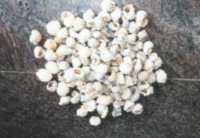Odour offensiveness of pig fed diets containing rock snail (Thais coronata) and the natural zeolite
Main Article Content
Abstract
Thirty six hybrid (Landrace × Large white) pigs, 26 to 28 weeks old with an average initial weight of 36.64 kg were assigned to diets containing (0.0, 0.2 and 0.3)g of Thais coronata and the natural zeolite respectively to determine the odour offensiveness of pig. The pigs were randomly allotted into six treatments of six pigs each, replicated three times with two pigs per replicate reared on a concrete-floored pen in a 2×3 factorial in a completely randomized design (CRD). Odour offensiveness was determined using 16 panelists in a five point scale. There were significant (P<0.05) additive (AD) × inclusion (IL) interactions in all the indices considered.Results showed that the odour offensiveness reduces as the inclusion level of the additives increases. It was concluded that the inclusion of Thais coronata can compare closely with the natural zeolite in mitigation of odour from the faeces of finisher pig.
Downloads
Article Details
Issue
Section

This work is licensed under a Creative Commons Attribution-NonCommercial-ShareAlike 4.0 International License.
How to Cite
References
AOAC (1990). Official Methods of Analysis. 5th Ed. Association of Official Analytical Chemists, Washington DC, USA.
Amaefule, K. U., Okechukwu, S. O., Ukachukwu, S. N., Okoye, F. C. & Onwudike, O. C. (2006). Digestibility and Nutrient Utilization of pigs fed
graded levels of brewers’ dried grain based diets. Livestock Research for Rural Development, 17.
Asia, I. O. & Akpohonor, E. E. (2007). “Characterization and Physicochemical Treatment of waste water from rubber processing factory.
International Journal of Physical Sciences,2(3): 061-067
Davis, R. A., & Fitzgenald, D. M. (2004). Beaches and Coasts.Blackwell, U.K., p. 419
Duncan, D. B. (1955). Multiple range and multiple F-test. Biometrics, 11: 1-42.
Hobbs, P. J., Pain, B. F, Kay, R. M.& Lee, P. A. (1996). Reduction of odorous compounds in fresh pig slurry by dietary control of crude protein.
Journal of Science and Food Agriculture, 71: 508-514.
Ki, Y. K., Han, J. K., Hyeon, T. K., Yoon, S. K., Young, M. R., Cheol, M. L., Hyun, S. K & Chi, N. K. (2007). Sulfuric odorous compounds emitted
from pig feeding operations. Atmospheric Environment, 41: 4811–4818.
Lu, M., Lamichhane, P., Liang, F., Imerman, E & Chai, M. (2008). Identification of odor causing compounds in a commercial dairy farm. Water Air Soil Pollution, 8: 359-367.
Milán, Z, Sánchez, E. &Weiland, P. (2001). Influence of different natural zeolite concentrations on the anaerobic digestion of piggery waste. Bioresource Technology, 80(1): 37-43.
Moeser, A. J., & Van Kempen, T. A. T. G. (2002). Dietary fiber level and enzyme inclusion affect nutrient


